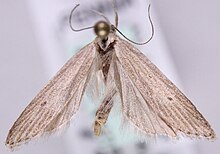Content deleted Content added
Collecting species of one genus, formerly scattered over two categories, into one new subcategory |
Chris lepidoptera (talk | contribs) mNo edit summary |
||
| Line 18: | Line 18: | ||
'''''Helcystogramma lineolella''''' is a [[moth]] of the [[Gelechiidae]] family. It was described by Zeller in 1839. It is found in most of [[Europe]], except [[Ireland]], [[Great Britain]], the [[Benelux]], the [[Iberian Peninsula]], [[Italy]] and the [[Balkan Peninsula]]. |
'''''Helcystogramma lineolella''''' is a [[moth]] of the [[Gelechiidae]] family. It was described by Zeller in 1839. It is found in most of [[Europe]], except [[Ireland]], [[Great Britain]], the [[Benelux]], the [[Iberian Peninsula]], [[Italy]] and the [[Balkan Peninsula]]. |
||
The [[wingspan]] is 19–20 mm.<ref>[http://www.lepidoptera. |
The [[wingspan]] is 19–20 mm.<ref>[http://www.lepidoptera.eu/show.php?ID=2448 European Butterflis and Moths]</ref> Adults are on wing from May to July.<ref>[http://www.lepidoptera.se/species/helcystogramma_lineolella.aspx Swedish Moths]</ref> |
||
The larvae feed on ''[[Calamagrostis epigejos]]'' and ''[[Calamagrostis arundinacea]]''. |
The larvae feed on ''[[Calamagrostis epigejos]]'' and ''[[Calamagrostis arundinacea]]''. |
||
Revision as of 18:30, 28 January 2015
| Helcystogramma lineolella | |
|---|---|

| |
| Scientific classification | |
| Kingdom: | |
| Phylum: | |
| Class: | |
| Order: | |
| Family: | |
| Genus: | |
| Species: | H. lineolella
|
| Binomial name | |
| Helcystogramma lineolella (Zeller, 1839)[1]
| |
| Synonyms | |
| |
Helcystogramma lineolella is a moth of the Gelechiidae family. It was described by Zeller in 1839. It is found in most of Europe, except Ireland, Great Britain, the Benelux, the Iberian Peninsula, Italy and the Balkan Peninsula.
The wingspan is 19–20 mm.[2] Adults are on wing from May to July.[3]
The larvae feed on Calamagrostis epigejos and Calamagrostis arundinacea.
References